Research themes in the Quantum Matter group
Overview
Our work focuses on two major themes in condensed matter research. The first is understanding the nature of quantum order in itinerant-electron systems on the border of magnetism at low temperatures. In recent years this area of research has led to the study of novel metallic states not described by Fermi liquid theory, anisotropic types of electron-electron and electron-hole pair condensates, and quantum critical phenomena. The second theme is studying the physics of novel superconducting materials, such as the high-Tc superconductors, MgB2, graphite intercalates and the ruthenates. The following sections give a more in-depth look at some of these areas, as well an overview of our experimental infrastructure.
Exotic States of Matter on the Edge of Magnetism
The crossover from ferromagnetism or anti-ferromagnetism to paramagnetism as a function of a 'quantum' control parameter such as pressure has turned out to be a much more subtle and interesting problem than was originally imagined in the early days of our field.
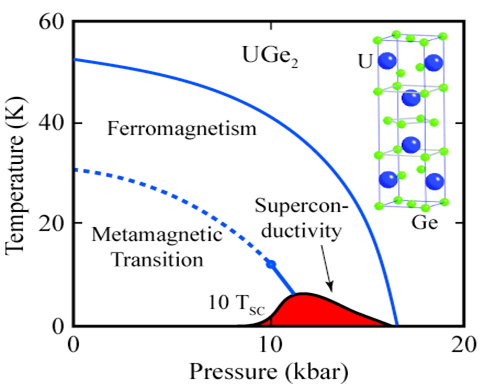 On the border of long-range magnetic order one expects several quantum states of more or less exotic nature to be nearly degenerate. Minute metallurgical or environmental changes can induce transitions between these states and give rise to complex behaviour that, in extreme cases, could be called 'adaptive'. Our research has focused on the investigation of the temperature-pressure phase diagram on the border of magnetism in relatively simple stoichiometric compounds of high purity in which well-defined forms of quantum order might be observed.
On the border of long-range magnetic order one expects several quantum states of more or less exotic nature to be nearly degenerate. Minute metallurgical or environmental changes can induce transitions between these states and give rise to complex behaviour that, in extreme cases, could be called 'adaptive'. Our research has focused on the investigation of the temperature-pressure phase diagram on the border of magnetism in relatively simple stoichiometric compounds of high purity in which well-defined forms of quantum order might be observed.
One such example is the ferromagnet UGe2, shown at left. Upon applying hydrostatic pressure in a pressure cell, the magnetic transition temperature TCurie, is suppressed towards zero, revealling a superconducting state at low temperatures. Superconductivity in a ferromagnetically ordered system is exotic and rare, and was thought impossible many decades. In this material there is also evidence that electrons pair up in an unconventional way, with spins aligned in the same direction forming an unusual 'spin-triplet' state.
Electronic Structure of Correlated Electron Materials
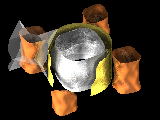
One of the most interesting aspects of modern condensed matter physics is the study of macroscopic manifestations of electron-electron correlations. Such correlations are generally strongest in nearly localised, "narrow band" systems where the Coulomb repulsion energy acquires a similar magnitude to the electronic bandwidth. Examples of such materials are the transition metal oxides, or the heavy fermion materials.
One way to gain insight into how these strong correlations affect the properties of these materials is to study quantum oscillations that arise in metallic samples in strong applied magnetic fields. Due to the wave nature of the electrons, the motion of electrons in a field leads to subtle interference effects which we can pick up, but only at the lowest temperatures, in very strong fields, and only for samples of very high purity. For this purpose, we have a dedicated cryomagnetic system, with fields up to 18 T and temperatures down to a few mK, and with a noise level that is amongst the lowest in the world.
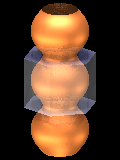
The exact form of the oscillatory interference pattern, and its dependence on field and temperature, gives us both the shape of the Fermi surface and the effective quasiparticle masses. An example of the Fermi surface of the complex oxide material Sr2RuO4 measured in our lab is shown at right. Quite often, these results are completely surprising and strongly deviate from theoretical predictions. For example, our recent study of the superconducting layered oxide Ag5Pb2O6 (left) revealed a Fermi surface totally at odds with theoretical predictions. In fact, thanks to our experimental results, this compound has been identified as the first ever (monovalent) nearly free electron superconductor.
Studies in heavy fermion materials, on the other hand, can yield effective mass values 100-1000x higher than electron masses in vacuum that cannot be inferred from first principles. The information so obtained forms an "identity card" for the metallic state on which theories of e.g. superconductivity and other Fermi liquid instabilities can be based.
Novel Superconductors
 After almost a century of research into superconductivity, this fascinating phenomena continues to yield surprises. One example is the recently discovered graphite based superconductors C6Yb and C6Ca (see figure at right), which are formed by intercalating Ytterbium or Calcium between sheets of Carbon atoms. These compounds superconduct at temperatures an order of magnitude higher than previous generation of intercalated superconductors, and have sparked debate as to the cause. Our group was involved in the discovery of these new materials, and there is an ongoing effort to characterize and study these and other graphite based superconductors.
After almost a century of research into superconductivity, this fascinating phenomena continues to yield surprises. One example is the recently discovered graphite based superconductors C6Yb and C6Ca (see figure at right), which are formed by intercalating Ytterbium or Calcium between sheets of Carbon atoms. These compounds superconduct at temperatures an order of magnitude higher than previous generation of intercalated superconductors, and have sparked debate as to the cause. Our group was involved in the discovery of these new materials, and there is an ongoing effort to characterize and study these and other graphite based superconductors. 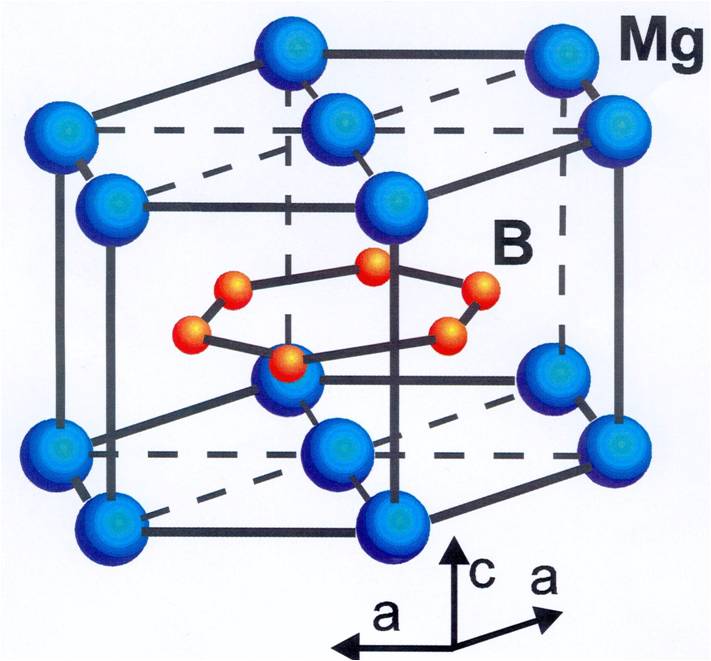
Similar to the graphite case, the superconductor MgB2 can be thought of as Magnesium layers sandwiched between hexagonal Boron layers, as depicted in the figure at left. With a remarkably high Tc of 39 K, this compound has attracted considerable interest, both from a theoretical and applications based perspective. Our group has been involved in studies of the Fermi surface of this material by using piezoresistive torque cantilevers to probe oscillations in the magnetization.
High Tc Materials
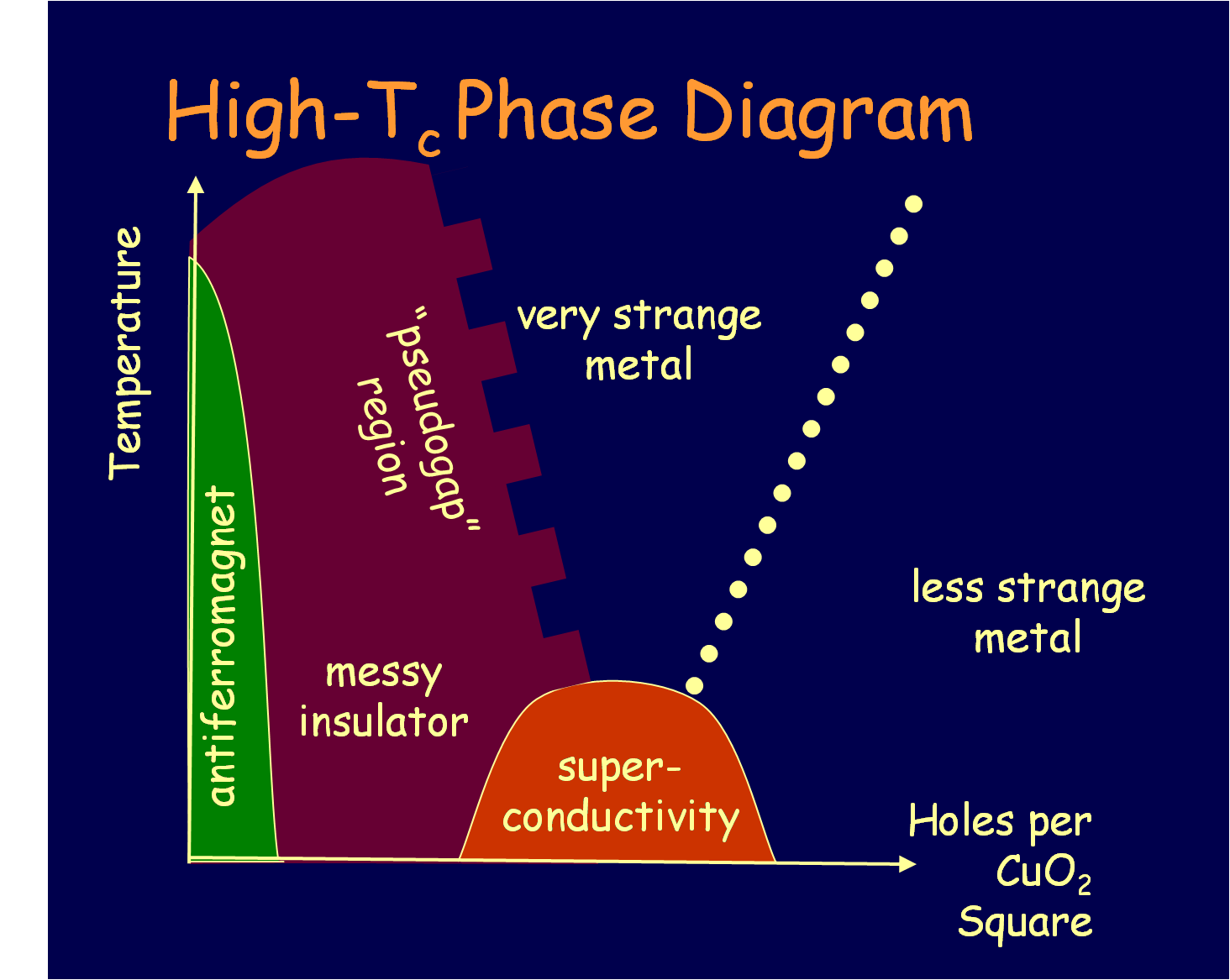 The high Tc superconductors are the class of materials with the highest recorded transition temperatures, on the order of 100 K and above. Discovered over 20 years ago, there remain a number of unanswered questions about these compounds. One of the key mysteries surrounds the identity of the so-called 'pseudogap' region of the phase diagram (see figure at right). In this regime there exists a gap like feature observed in many physical quantities, yet there is no obvious signs of an ordered phase. Some of the research in the group has been directed at studying the specific heat of the high Tc's in the pseudogap region of the phase diagram. A second intriguing questions is surrounds how the high-Tc's evolve with charge carrier concentration (doping), moving from an antiferromagnetically ordered insulator at low doping, to an unconventional superconductor and eventually a Fermi liquid metal at higher doping. At low doping, there is evidence for a 'glassy' behaviour of electronic spins, and part of our research effort is directed towards exploring this region of the phase diagram through muon-spin relaxation, transport and dielectric measurements.
The high Tc superconductors are the class of materials with the highest recorded transition temperatures, on the order of 100 K and above. Discovered over 20 years ago, there remain a number of unanswered questions about these compounds. One of the key mysteries surrounds the identity of the so-called 'pseudogap' region of the phase diagram (see figure at right). In this regime there exists a gap like feature observed in many physical quantities, yet there is no obvious signs of an ordered phase. Some of the research in the group has been directed at studying the specific heat of the high Tc's in the pseudogap region of the phase diagram. A second intriguing questions is surrounds how the high-Tc's evolve with charge carrier concentration (doping), moving from an antiferromagnetically ordered insulator at low doping, to an unconventional superconductor and eventually a Fermi liquid metal at higher doping. At low doping, there is evidence for a 'glassy' behaviour of electronic spins, and part of our research effort is directed towards exploring this region of the phase diagram through muon-spin relaxation, transport and dielectric measurements.
Quantum Ferroelectrics
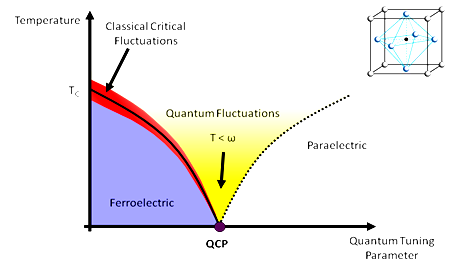 The simplest ferroelectric materials turn out to provide a 'text-book' example of quantum criticality in the solid state. Ferroelectrics are materials that when cooled below their phase transition temperature Tc, undergo breaking of lattice inversion symmetry and spontaneously develop a macroscopic polarization. Pressure can be used as a 'quantum tuning parameter', as shown in the first figure, to suppress Tc towards absolute zero. In the region where the temperature scale is much less than the Debye temperature of the lowest transverse-optic soft mode, quantum rather than classical statistical mechanics are required to understand the observed behaviour. In this (yellow) region, order-parameter fluctuations are typically found to exist in a four-dimensional space and the lattice is observed to fluctuate in a wildly unconventional form.
The simplest ferroelectric materials turn out to provide a 'text-book' example of quantum criticality in the solid state. Ferroelectrics are materials that when cooled below their phase transition temperature Tc, undergo breaking of lattice inversion symmetry and spontaneously develop a macroscopic polarization. Pressure can be used as a 'quantum tuning parameter', as shown in the first figure, to suppress Tc towards absolute zero. In the region where the temperature scale is much less than the Debye temperature of the lowest transverse-optic soft mode, quantum rather than classical statistical mechanics are required to understand the observed behaviour. In this (yellow) region, order-parameter fluctuations are typically found to exist in a four-dimensional space and the lattice is observed to fluctuate in a wildly unconventional form.
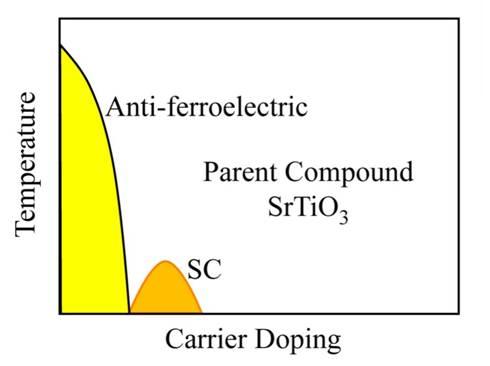
Going beyond the simplest ferroelectric materials can lead to a much more complex picture. Coupling of the critical ferroelectric modes to other degrees of freedom such as magnetic excitations, delocalised electrons or other phonon branches is expected to give rise to a rich phase diagram of physical phenomena. This has motivated our research in for example, multiferroic materials and ferroelectric metals. Evidence in fact exists for superconductivity on the boundary of a ferroelectric state in a number of materials, as exemplified by the second figure shown, where one expects the ferroelectric polarization waves to interact with the electron liquid.
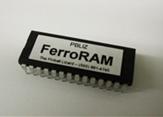
Technological applications of quantum ferroelectric materials include novel cooling systems, energy storage units, sensing devices and computer memory.
Infrastructure
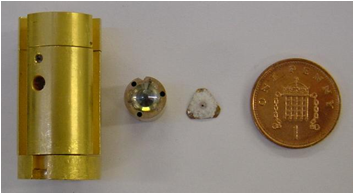 The experimental infrastructure in the quantum matter group offers access to extreme environments. We have low temperature probes capable of achieving base temperatures of 2 mK in an 18 T magnetic field, and diamond anvil cells capable of pressures up to 300 kbar. We are actively involved in developing cryogenic technologies using the technique of adiabatic demagnetisation, as well as developing methods for reliably achieving high pressures. An example of a diamond anvil cell constructed by Sam Brown in our lab is shown at left.
The experimental infrastructure in the quantum matter group offers access to extreme environments. We have low temperature probes capable of achieving base temperatures of 2 mK in an 18 T magnetic field, and diamond anvil cells capable of pressures up to 300 kbar. We are actively involved in developing cryogenic technologies using the technique of adiabatic demagnetisation, as well as developing methods for reliably achieving high pressures. An example of a diamond anvil cell constructed by Sam Brown in our lab is shown at left.
| High pressure susceptibility setup with external modulation coil and internal sensing microcoil | Transport measurement on diamond anvil, crystal sculpted with focused-ion beam (with T. Helm, Dresden) |
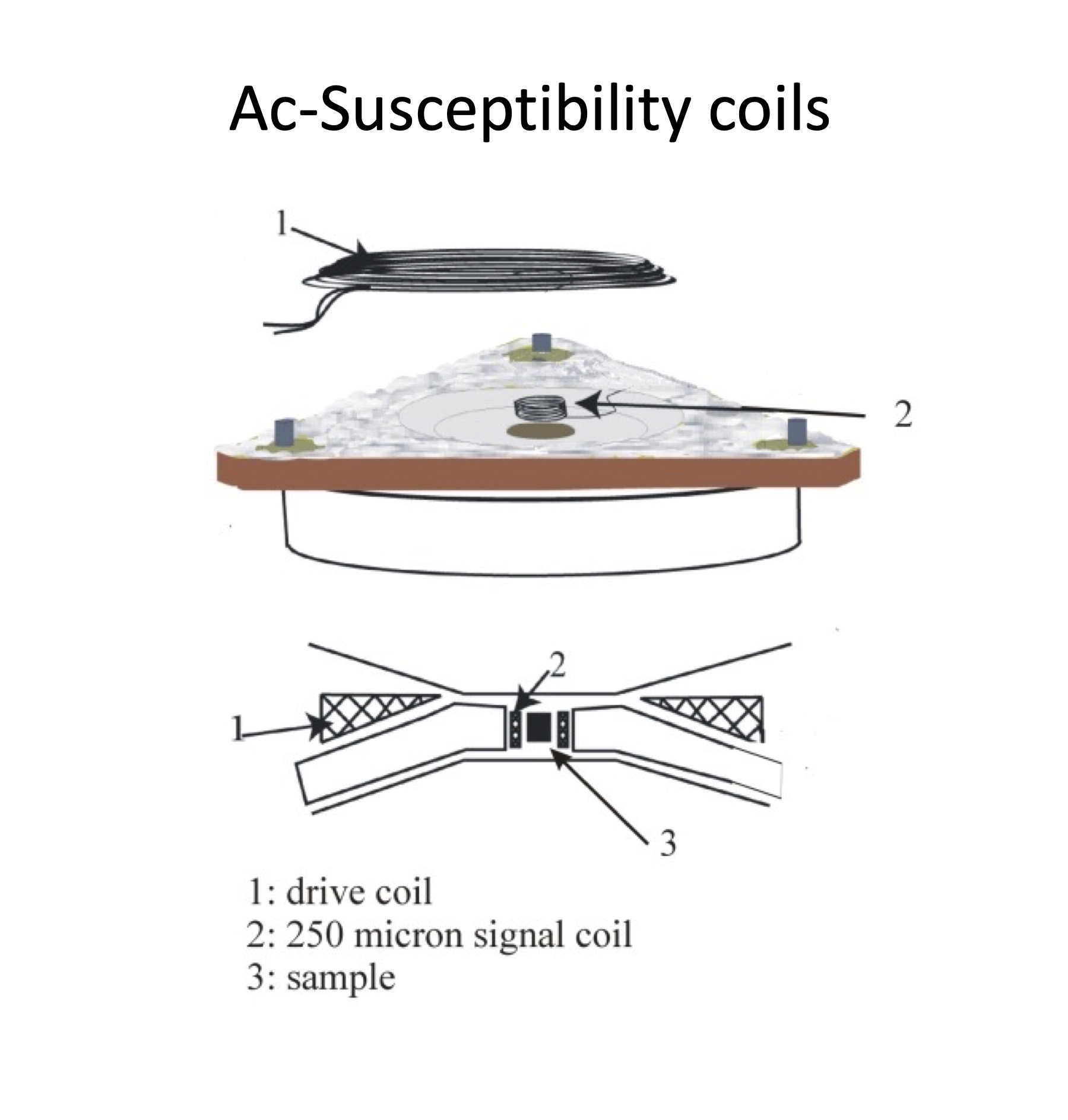 |
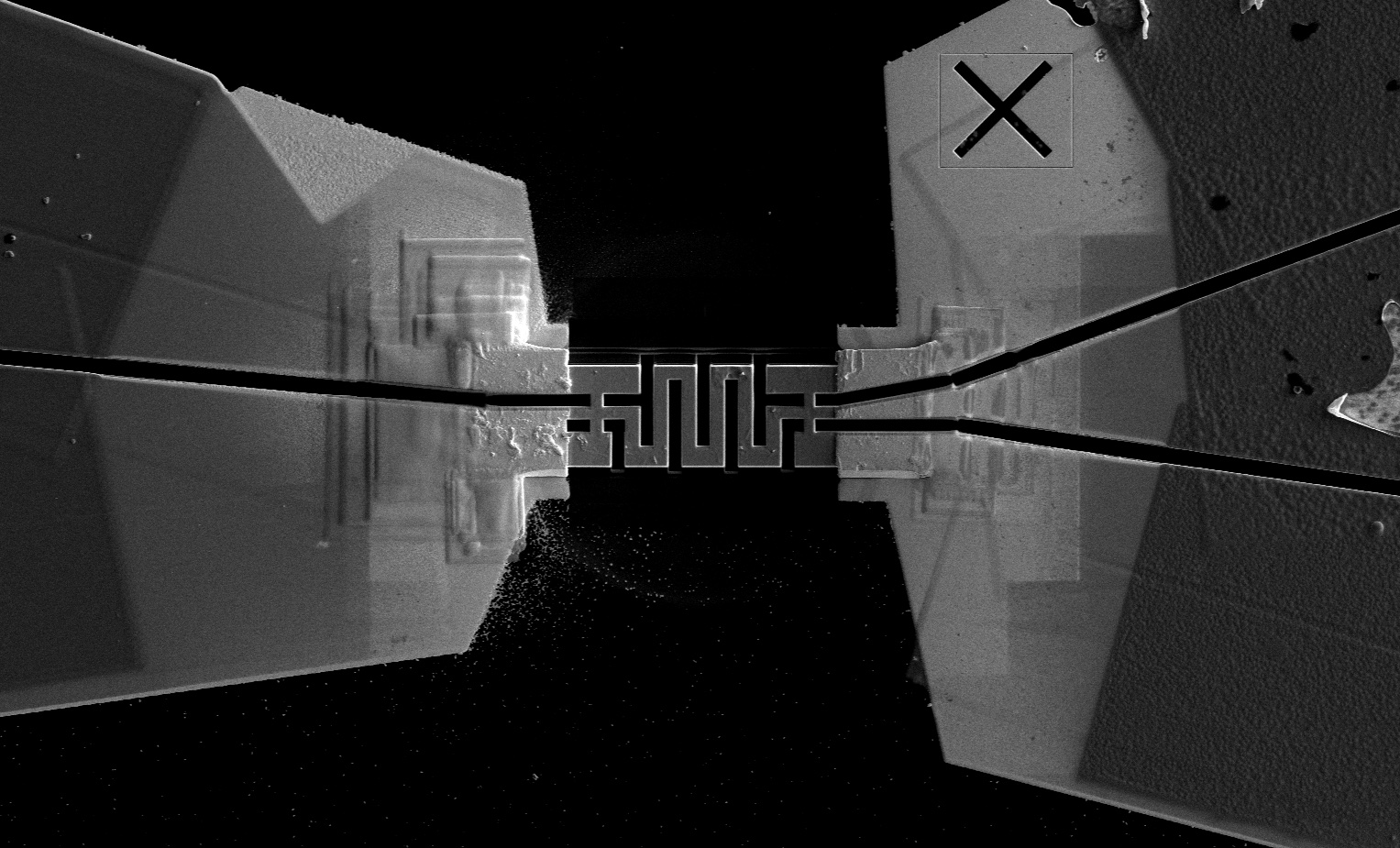 |
Our facilities include:
- A dilution refrigerator system capable of temperatures as low as 2 mK with magnetic fields as high as 18 T.
- Two adiabatic demagnetisation refrigerators capable of base temperatures below 50 mK.
- Several 3He cryostats capable of temperatures of 300 mK, some with superconducting magnets.
- A continuous-flow cryostat giving stable temperatures down to 3 K with a conventional magnet giving fields up to 1 T.
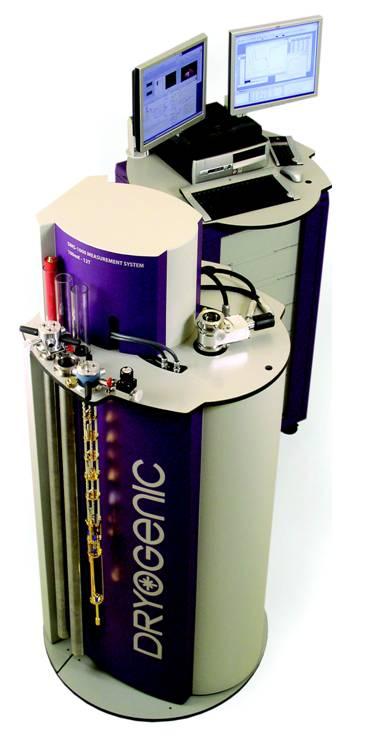
- New cryogen free adiabatic demagnetisation cooler, which enables high pressure experiments to be performed at millikelvin temperatures in a routine manner with a fast turnaround time. The system is based around low vibration pulse tube refrigerators to cool from room temperature to 4 K, and a two-stage adiabatic demagnetisation refrigerator to cool to 1 mK.
- Various conventional 4He cryostats giving temperatures down to 1 K, some equipped with superconducting magnets.
- Electronics and equipment for ultra low noise signal detection.
- Several furnaces dedicated for crystal growth and materials purification, using both flux growth and rf-induction techniques.
- A number of piston-cylinder fluid clamp cells, both magnetic and non-magnetic, reaching pressure of up to 35 kbar.
- Diamond, Sapphire and Moissanite anvil cells that can be used for transport and susceptibility measurements at pressures up to 300 kbar.
- We also have a number of collaborations with groups both within the UK and abroad, giving access to a wide array of complementary techniques and facilities.
